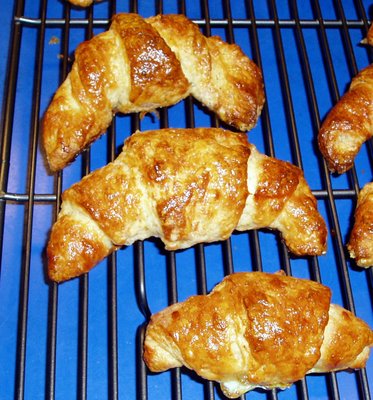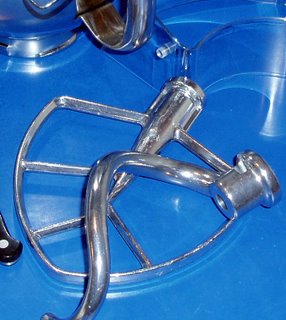This is not my very last bread--I still have one to make--but it's the only one that has been unsuccessful, so I felt that I had to give it another try. This time it worked. But I can't figure out why this time, both the original focaccia and the variation, with garlic poached in olive oil, were rousing successes and very easy, and the first time nothing went right.
The directions say that the dough will be very soupy, but after beating for about 20 minutes, it will be "transformed into a smooth, shiny ball."
On my first attempt, that transformation never occurred--it just stayed soupy. After about 25 minutes of waiting for the transformation to occur, I added more flour, but it still stayed soupy. I tried baking it anyway, but it never metamorphosized into anything resembling bread.
This failure has galled me for my entire year of baking bread.
Elizabeth was still at home for her Thanksgiving break, and she said she wanted to try her hand at bread baking too, so she opted for the focaccia with pockets of garlic variation. After she heard about my first attempt, she said she would simply use less water. I told her it was supposed to be a very wet dough. She said, "Mom!" (Generally when she says "Mom" with an exclamation mark, it means I've said something stupid.) "Mom! Haven't you ever heard of the scientific method? We'll experiment!" As it turns out, neither of us followed the recipe precisely, but her change was deliberate and mine were accidental. And both methods gave us beautiful bread.
I intended to measure everything with great precision, but, as usually happens when I start baking before I have my full measure of coffee, I made a few errors. I used 3/4 teaspoon of yeast instead of 3/8 because I got confused. And I started pouring in the water before I had even measured it, so I measured out 442 grams (the correct amount) and poured out approximately the same amount that I'd already added to the flour. While I was doing this, I kept telling myself that I should just start over. After all, I'd only be wasting flour and water. But I just kept going. And this time, right on schedule, after 20 minutes of beating, the dough miraculously turned into the shiny, smooth ball.

And, even more miraculously, when I poured it into the dough-rising container, it looked exactly like "melted mozzarella," just as it was supposed to look.

Because I'd doubled the yeast, my dough rose in 2 hours. While I was waiting, I poached the garlic for Elizabeth's bread. The poached garlic is fabulous--even better than roasted garlic because the temperature is easier to control, and the garlic becomes soft and creamy without getting hard and chewy on the outside. And, of course, you're left with garlic-infused olive oil. The only disadvantage is that garlic permeates the air of the entire house, causing both your eyes and your mouth to water.
After being baked for just 13 minutes, the stretchy, shiny dough turned into the best focaccia I've ever tasted, and we dug into it immediately. It was crispy, but incredibly light and airy. It was not just bread, it was vindication!
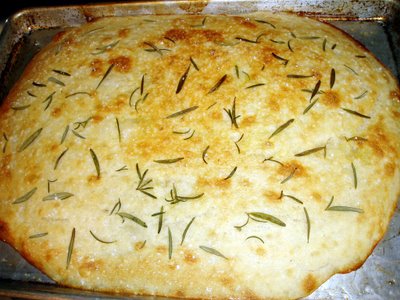
I remembered the testy e-mail I sent to Rose after my first failure, telling her that she should get rid of this recipe in the next edition. NO! Pay no attention to that e-mail! It not only works when you follow the directions, but it also works even when you don't follow directions.
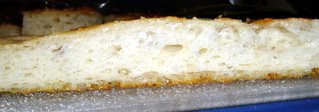
After the three of us greedily ate the rosemary focaccia, the less yeasty dough was ready to receive its garlic. Elizabeth and I made pockets in the dough--hers, like mine, was smooth and very elastic--and worked in the golden bits of garlic. In another 13 minutes, out came another perfect pan of focaccia--and this one was even better than the first.

My 82nd bread this year; Elizabeth's first ever. And both of them superb. Thank you, thank you, Rose, for not listening to crotchety people like me and for insisting that this wonderful bread can indeed be baked perfectly.

So what happened? What accounts for the difference? I can think of only a few possibilities. This was my first loaf of bread and I used flour that I'd had on hand. Because I didn't do that much baking, my flour might have been middle-aged if not elderly. This time, I opened a brand new package of King Arthur all-purpose flour. Or the first time, I was measuring the old-fashioned way: with cups and teaspoons. Now I use a scale and no longer understand why we don't weigh instead of measure in this country. Or it could be my shiny new KitchenAid. But my friend Sara has made this bread without incident many times using her old Artisan model. Finally, I might try to chalk it up to experience, except that Elizabeth's bread turned out as well as mine, and she has no experience at all. (Although she was guided by me, which must be worth something).
If my first description of baking this bread has discouraged anyone from baking this, or if, like me, you've tried and failed, I beg you to pluck up your courage and open The Bread Bible to page 205. You'll be glad you did.
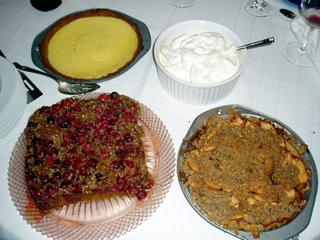


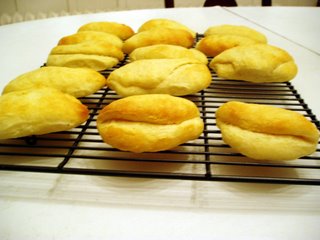


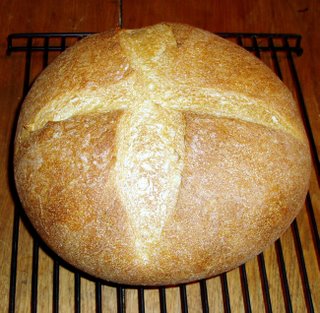

 alt="" />
alt="" />
